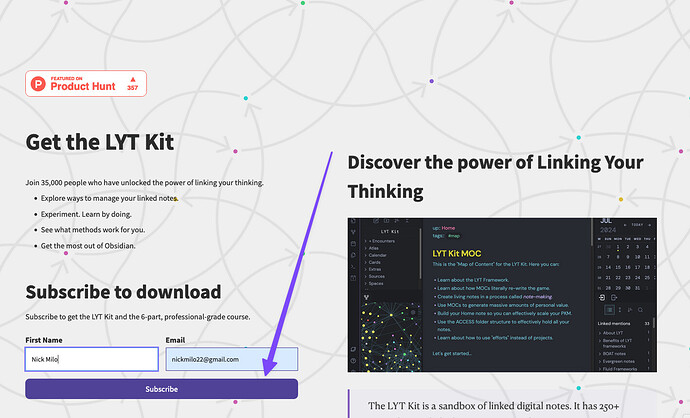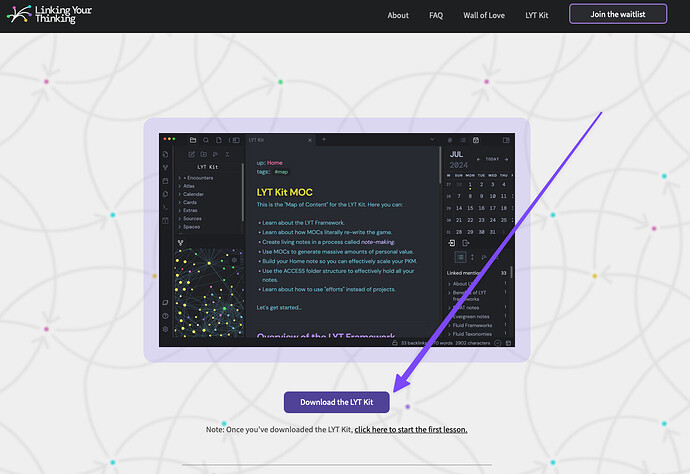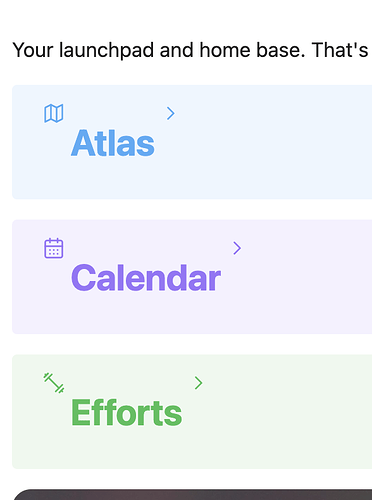Is it possible to copy the LYT style and functions to my own vault? Or is the idea to customize the LYT vault?
LYT design can be implemented inside your vault by usage of LYT Mode theme inside Obsidian.
Projects/Efforts/Initiaitives/Spaces…
Hi-
I am using LYT 7 to see if I can build some conscious structure to my workflow. One thing I am recognizing about my life is that I start various initiatives, such as losing 5% body fat, working to build muscle, focusing on a specific non duality area (including study, inquiry, meditation, etc). I have these various things that are “active” in my life right now that I want to keep a track of.
I was looking at Spaces and Efforts and I am a little confused. What’s the different between a Space and Effort? I assume a Space could have multiple sub-efforts? Are these the right parts of the framework to use to track these types of things, or is there a better/different approach people use?
Thank you,
mf
Hi @mettafort ,
I currently don’t use a kind of habit tracking that much.
I only create a table via the dataview plugin to refer to my daily notes where some inline metadata is included.
I could imagine that the plugin GitHub - pyrochlore/obsidian-tracker: A plugin tracks occurrences and numbers in your notes could be useful for you? But sorry, I cannot provide more information as I haven’t used this plugin yet.
@romanov.maxim Absolutely correct. If i may expand upon what you said:
-
An ontology means one of the many canonical, agreed-upon, or formal hierarchies of topics/subjects.
-
An MOC, or any other map created by hand, with/without tags, is necessarily a PERSONAL record, which should also be annotated with one of the canonical ontologies.
-
The whole idea is to re-use a canonical ontology to make our MOC journey easier, and NOT re-invent the wheel…not least, because our "wheel’ may not jive with the classical wheel.
-
Some examples of canonical ontologies:
Music>Rock, Classical, Contemporary, Regional (etc etc).
Rock> Progressive, Electronic etc etc.
The above representation CANNOT be flat, it is necessarily a tree (hierarchy), which is for sure 2-dimensional and could even be 3-dimensional.
-
If I digest information about “bel canto” singing, or “blues scales”, and write it, it NECESSARILY belongs to one or more of the canonical music ontologies mentioned above. I can use my own #tag(s), but that cannot and should not replace the fact that the piece of knowledge has an academically acknowledged place in the universal ontology of music.
-
Wikipedia (obviously) uses an ontology. I don’t know if it is open-source, or what, but you will often see “This article belong to a series on XYZ”, and a hierarchy of topics is often also linked to.
-
Obsidian, in order to become a complete PKM solution, or at least a universal one, needs to be able to connect to the academically/classically acknowledged characteristics of knowledge
For example, in any article i write, i should be able to use an Obsidian feature (OR plugin) to indicate its place in one or many canonical ontology: Example, link to “child concepts”, link to the “parent concept”, link to a “sibling concept”, AND a way to enforce ORDERING OF THESE CONCEPTS.
For example, it is impossible to understand “semiconductor”, without first understanding. “electricity”, “conductor”, and “doping”. Any article on semiconductor should make this ordering, and/or ontology obvious…or, let the user make these links.
Download UI is confusing. Went back to email and found the link. My experience 1. clicked on the link on this page 2. Go to your page with Download button in the upper right corner 3. See that I have to “enrol” 4. I get taken to a new page with no down load link. ( NO I don’t read all the text, I want download). 5. Eventually I go back to inbox ( I gave up) and see a previous email with a link to download. You guys are smart - make this easier.
If you click the correct link it can’t be simpler and you’ll have it downloaded in seconds:
Go here and enter your name and email. Hit Subscribe.
A new page opens. Hit Download the LYT Kit.
You will have downloaded the LYT Kit.
That’s it. Pretty smart ![]() Good luck Dave (@dbgnvan).
Good luck Dave (@dbgnvan).
HI, I’m a newbie here. Just wanna ask a quick question: when I go to the link to download LYT KIT, I just can’t hit the subscribe button. Is there any problem with this button or am I entering wrong thing into the First Name and email?
Or this link no longer works anymore? ![]()
There’s your problem! I bet you don’t read instruction manuals either! ![]()
Hi @nickmilo ,
Thank you for putting this together. BTW, what is a datascope?
Excited to share the latest iteration of Ideaverse for Obsidian (formerly known at the LYT Kit). We’re launching on Product Hunt tomorrow. I’ll share a link here for the free download and update the OP. Best, Nick
Just launched it on Product Hunt here: Ideaverse for Obsidian - A Starter Kit to Manage Your Whole Life | Product Hunt
If you feel compelled to support the launch by going there engaging, that would sure be appreciated.
Enjoy,
Nick
Immediately makes tracks to Product Hunt!
I’m running Ideaverse for a couple of days now and watched the videos so far. That’s such a great work!! It’s hard to find adequate words. A milestone for PKM. I’m not the kind of person who is getting enthusiastic about such things, but this is something special. Thank you ![]()
There’s just a small issue: The callouts got some weird line breaks when using another theme than Prism.
Is there any kind of (hidden) setting or workaround?
Best, Thomas
Maybe some bugs because of the latest version of Obsidian, usually Damian creates solid code.
You’ll have to check his github issue tracker if there’s already a bug report for it.
As a shot in the dark, I’m guessing Ideaverse callouts use Headings inside of the Callout title which other themes might not handle well hence the odd placement of the icons. You could probably change the Heading text to normal text and it should look correctly in the theme you are using.
I think that’s actually a normal line break. The callout has its own icon (and sometimes title) which is what you see there with the drop-down arrow, and the heading is actually nested inside the callout box – so it actually is on the next line.
@nickmilo I especially love your stuff because I think our brains work pretty similarly. Right down to the fact that I just noticed in my exploration of the Ideaverse vault that you use monthly notes rather than regular daily notes. I’ve been making my monthly notes manually, and you’re the first other person I’ve heard talk about using monthly notes mostly in lieu of dailies. What do you use for making/maintaining your monthly notes?
Obviously I’m not Nick. But I have the same issue, of needing to frequently reference content that has a tendency to disappear from the internet, so I have a habit of saving everything so I’ll know I have it.
But I don’t save everything in my notes. I download the papers/print the web articles/etc. – and save them in a traditional folder structure in my hard drive. And I only save to my notes vault articles I expect to actively use and link, or my own clippings and/or commentary from articles.
So then my overall hard drive is more like a traditional library and Obsidian is more like my brain.
Thanks Nick, I’m finding ACE very helpful, even the free version. Question re ideaverse: in the note “Atlas/Maps/Library.md” there is block about “The LYT Classification System” based in part in Cutter, Dewey, and Universal Decimal classification systems. I thinking, you just left that as reference or LYT Kit can be plugged into ideaverse?
Thanks for asking. The same idea would apply in Ideaverse.


